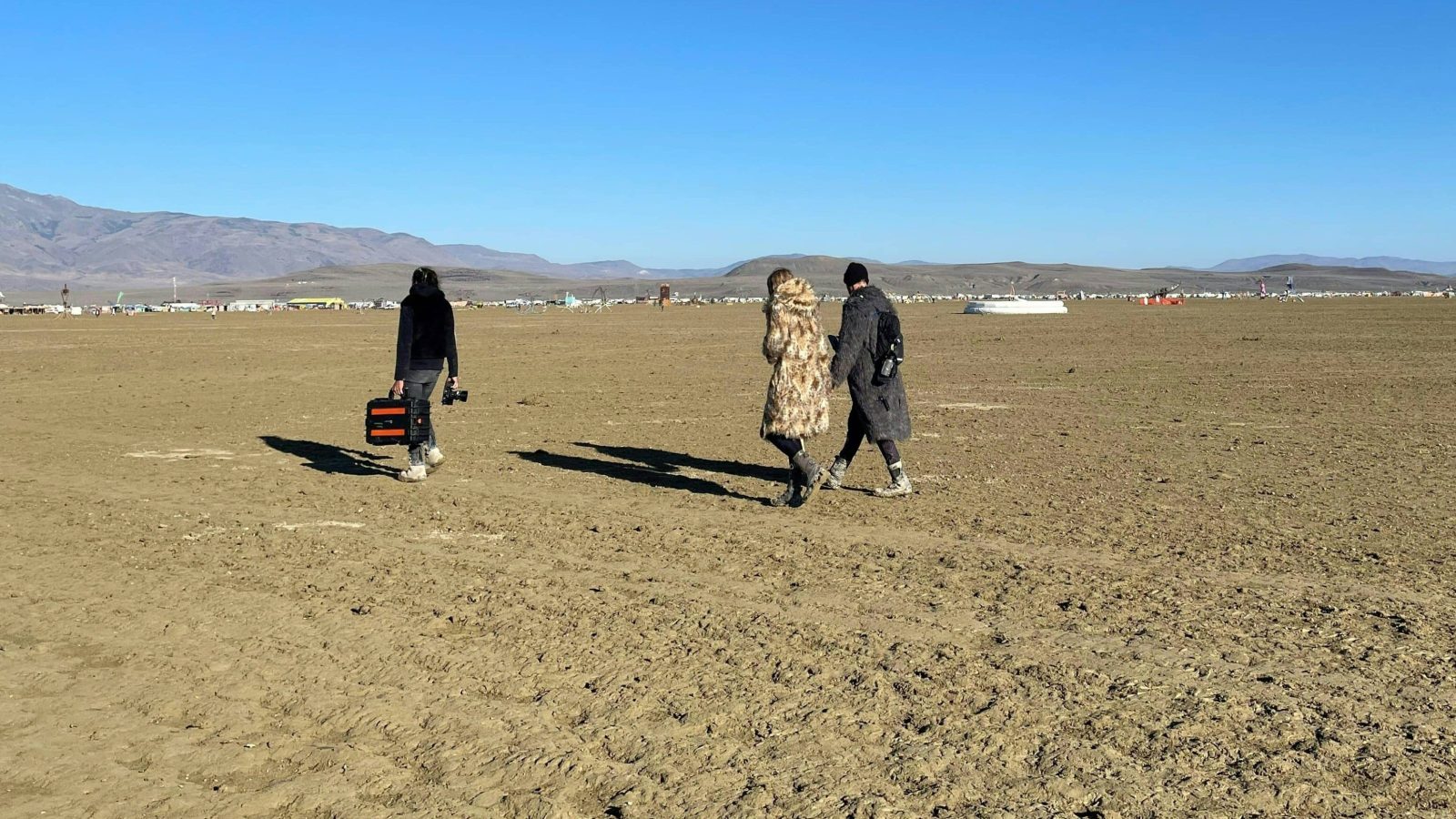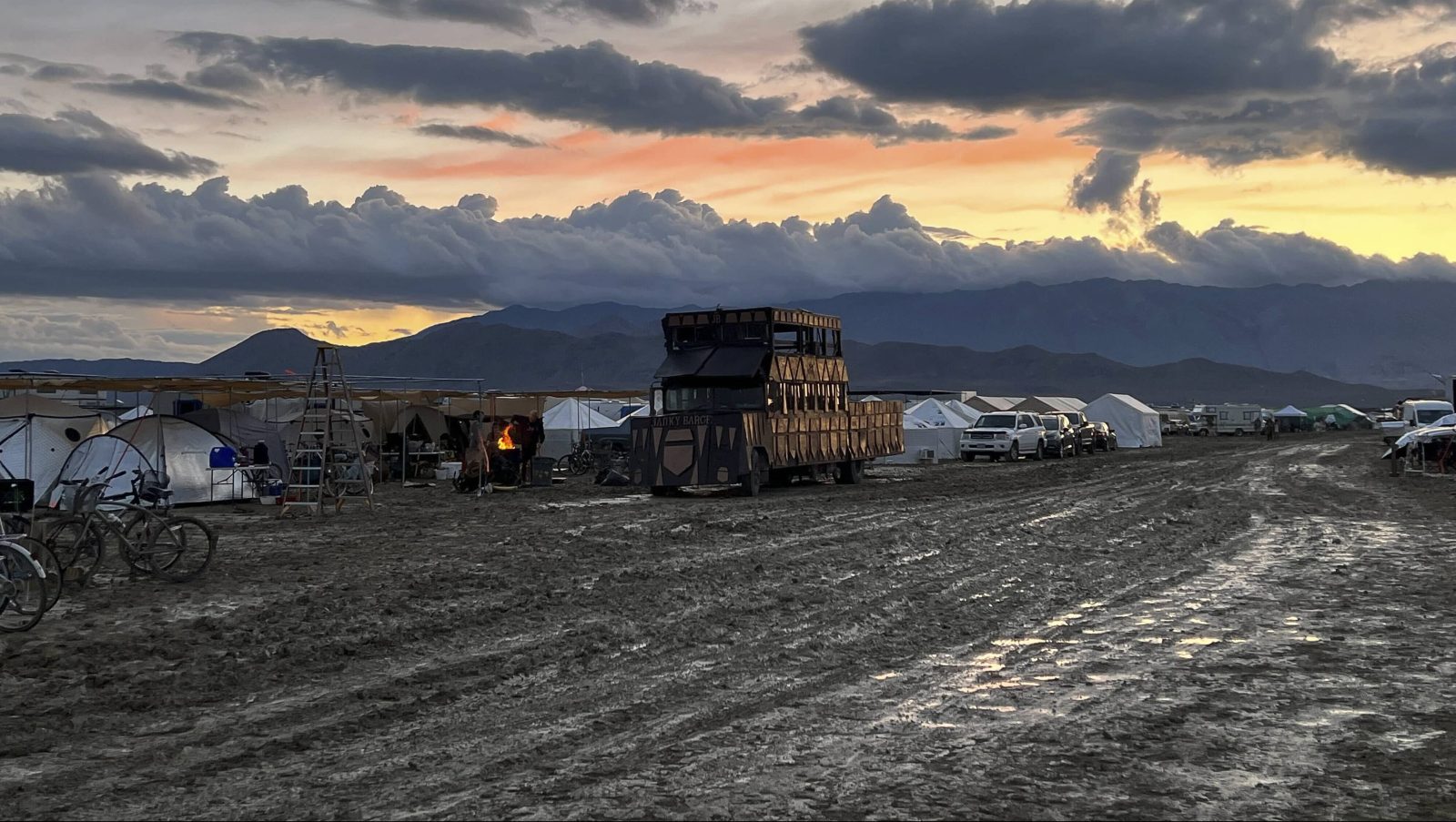Burning Man, the transient bacchanal that attracts more than 70,000 partygoers to the remote Nevada desert for eight days every August, prides itself on its environmental bona fides. One of the festival’s main operational tenets is “leave no trace,” an essentially impossible feat for an event of its size. The Burning Man Project, the organization that runs the festival, has set a goal of becoming “carbon negative” — removing more emissions from the environment than the festival produces — by 2030.
It’s a tall order: The festival generates around 100,000 tons of carbon dioxide every year, the equivalent of burning over 100 million pounds of coal. A series of disasters at this year’s festival have brought the gap between Burning Man’s rhetoric and reality into sharp relief: First, a half dozen protesters demanding stronger environmental commitments from the organization blocked the festival’s entrance for roughly an hour before they were forcibly removed. Days later, torrential rain — the kind of event made more likely and extreme by climate change — stranded revelers in a dystopian free-for-all. But the greatest irony of all may be Burning Man’s less-publicized opposition to renewable energy in its own backyard.
Burning Man’s problems began on August 27, the first day of this year’s festival, when a blockade of climate protesters created a mileslong traffic jam on the two-lane highway into the dry lakebed of the Black Rock Desert, about 120 miles north of Reno, Nevada, where Burning Man takes place. In addition to calling for “systemic change,” they demanded that festival organizers take immediate steps to decrease the event’s carbon footprint. Burning Man, which started out as a small gathering of artists on a beach in San Francisco in the 1980s, has grown into a massive event that attracts a growing percentage of the world’s ultra-wealthy every year. The protestors, who were ultimately dispersed by police, demanded the festival “ban private jets, single-use plastics, unnecessary propane burning, and unlimited generator use per capita,” among other requests.

Then, torrential rain spurred by a late-August hurricane and the onset of monsoon season in the desert turned the festival into a gargantuan mud pit, stranding attendees and forcing Burning Man to close the roads into and out of the festival from Friday until Monday afternoon, when conditions improved. Since no supplies could be trucked in or out, partiers were forced to ration water and other supplies. Some people, including the DJ Diplo and the comedian Chris Rock, abandoned their vehicles in the desert and walked out of Black Rock City, as the festival site is known, on foot. (It’s 15 miles from Black Rock City to Gerlach, the nearest town.) The rain caught festival goers off guard, but experts say floods like the one that inundated Black Rock City are a forecasted consequence of climate change.
“The well-known southwestern summer monsoon is expected to yield larger amounts of rainfall in a warming climate,” Michael Mann, presidential distinguished professor in the University of Pennsylvania’s Department of Earth and Environmental Science, told Wired.

A broad consensus exists, of course, on how to slow the climactic changes that are beginning to wreak havoc like this: Replace the fossil fuels that currently power much of the world with a wide variety of carbon-free sources. In fact, the federal government approved one such project, a geothermal energy initiative in the Nevada desert a mile outside of Gerlach, last year. The exploratory project, funded by an international renewable energy company called Ormat Technologies, aims to find out whether geothermal — which taps naturally occurring heat under Earth’s surface to produce clean energy — is commercially viable in the Nevada desert.
But the venture faced immediate pushback from the Burning Man Project, one of a group of plaintiffs that sued the Bureau of Land Management, or BLM, over its approval of up to 19 exploratory geothermal wells in the Black Rock National Conservation Area. The Burning Man Project, the lead plaintiff in the lawsuit, also worked with residents of the tiny town of Gerlach, the hamlet closest to the geothermal development, to appeal the BLM’s decision. The wells, the organization said, would “threaten the viability” of Burning Man’s various projects in Nevada by potentially jeopardizing local hot springs in the area and disrupting the desert ecosystem. The plaintiffs argued that BLM had approved the project without adequate environmental review and hadn’t sufficiently consulted local communities, including the Summit Lake Paiute Tribe, in its permitting process.
“People travel to Gerlach to experience the solitude of the vast open spaces and undeveloped vistas present in the Black Rock Desert,” the lawsuit said, “as well as to attend numerous events and to pursue a variety of recreation experiences in the undeveloped desert.”
After the lawsuit was filed, the Washoe County Commission in Reno ultimately voted 3-2 against the proposed geothermal project, a move that baffled clean energy experts and overturned the county’s prior approval of the project.
The claim that the region remains relatively undisturbed, given the 70,000-person party that rolls in every year, rang particularly hollow.
“Some of the hype around Gerlach has been disturbing from a scientific point of view,” James Faulds, Nevada’s state geologist, told Grist. “The Gerlach area has already been disturbed by man.”
Faulds added that no hot springs in the area besides the ones located immediately above the actual geothermal wells would be affected by the development, and that the geothermal power plant itself wouldn’t be visible from the Burning Man festival. (The Burning Man Project did not respond to Grist’s requests for comment.)
Ormat may try to appeal the county’s decision or scrap the project and apply to build new geothermal development elsewhere in the state instead. “Ormat will continue to press forward with exploration and development of its renewable energy projects throughout the State of Nevada to help the state and federal government meet their renewable energy goals,” the company said in a statement following the county commission’s vote.
A single megawatt of geothermal energy can provide enough power for up to 1,000 residential homes year-round. That gives it a smaller land-use footprint than either wind or solar power, Faulds pointed out.
“Let’s say that power plant is producing 30 megawatts. You could drive by that and say, ‘Huh, that’s 30,000 homes,’” Faulds said. “That could be a big chunk of homes in a city in Southern California or Northern California, wherever the power is being sold to — where a lot of the Burning Man folks, of course, come from.”



